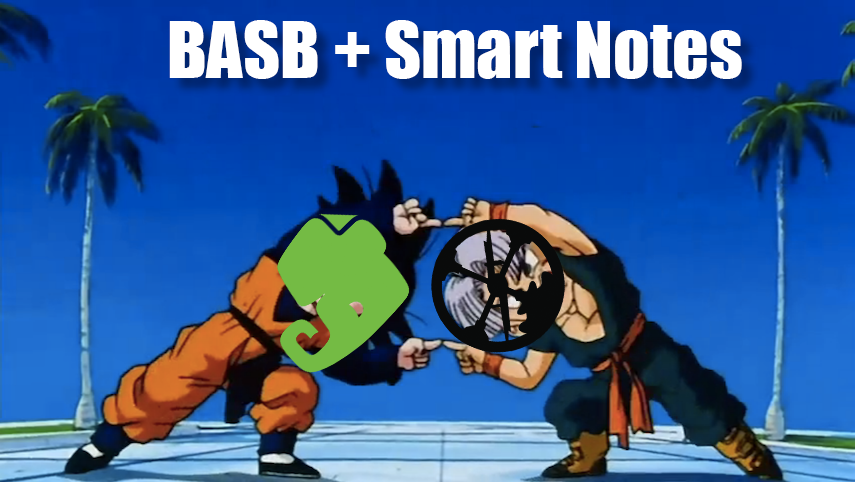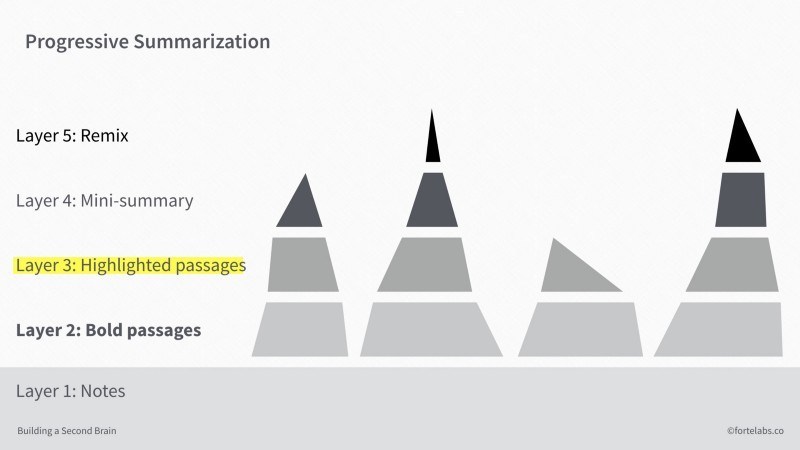Building a Second Brain + Smart Notes
Building a Second Brain. How to Take Smart Notes. Two knowledge management systems, battling it out for the hearts of productivity nerds worldwide.
Fortunately, you don’t have to choose a side.

A fusion of the two is possible, producing a knowledge management system with the best of both worlds. I describe my approach below.
For the uninitiated, I give a brief overview of each system. If you’re already familiar, feel free to skip down to this section.
Building a Second Brain

Building A Second Brain (BASB) is a Personal Knowledge Management system created by Tiago Forte. BASB is oriented around action–notes are primarily organized by projects or areas of interest. Deep dives into your notes are prompted by the needs of an active project. This ensures relevant ideas are pulled out just-in-time.
One of the main ideas in BASB is Progressive Summarization (PS). It’s a method for making new information easily discoverable by your future self.
Rather than going through a complicated process for every piece of information you encounter, PS is performed in layers.
- Layer 1: Notes
- Layer 2: Bold Passages
- Layer 3: Highlighted Passages
- Layer 4: Mini-summary
- Layer 5: Remix
Each successive layer is added opportunistically whenever you come across the note, rather than all at once.
By going over your notes in multiple passes, the most important ideas become easier and easier to find, and you waste a minimum amount of time on unimportant ideas. PS enables you to do only as much or as little work as the information deserves.
Progressive Summarization and other principles of Building A Second Brain combine to create an extremely useful knowledge management system. A well tended second brain enables faster and higher quality output.
Despite BASB’s power, an older idea is threatening to steal the limelight.
The zettelkasten, aka Smart Notes

Zettelkasten is the German word for “slip box”. When you encounter a new idea, you write it on an index card, and place it in your slip box.
A few key principles guide what kind of information should go on your index cards:
- Notes should be atomic–each note should be about one idea, but encapsulate that idea well enough to stand on its own.
- Notes should be written in your own words, rather than copied or quoted.
- Notes should be linked to other notes with related concepts.
Someone with a large zettelkasten will never experience blank page syndrome. Pull out note cards related to a theme, put them in a sensical order, and suddenly you have an outline for an article, a paper, or even a book.
Sociologist Niklas Luhmann is well known for his 90,000+ card zettelkasten, which helped him write over 70 books! Authors Robert Caro, Robert Greene, and Ryan Holiday use similar systems when writing. I suppose if your name starts with an R you are obligated to use a zettelkasten.
Unfortunately, this sort of cross-referencing and organization with physical index cards can be cumbersome. For many years the zettelkasten has remained a relatively unknown oddity.
Two things have brought Luhman’s slip box out of storage:
- The book How to Take Smart Notes by Sonke Ahrens (2017). This concise summary of the method has brought zettelkasten back into the zeitgeist.
- Roam Research, a digital knowledge management tool. It’s key idea–bi-directional links–makes the type of cross-referencing needed to maintain a Zettelkasten much easier.
This resurgence in popularity has made productivity nerds question their allegiances. Should we use BASB, or Smart Notes?
Differences between Building A Second Brain and Smart Notes
Zettelkasten differs from BASB in two key ways: what information to store in your notes, and when to review those notes.
The Smart Notes methodology opposes highlighting, correctly stating that it’s a poor way to learn material. BASB actively encourages highlighting, not as a way to learn, but as a way to reduce the work needed to summarize ideas later.
When you add a new card to a zettelkasten, you review your old cards to link concepts together. Contrast this with BASB, where old notes get reviewed opportunistically based on active projects.
Building A Second Brain + Smart Notes
We’ve got two seemingly great options at odds with each other–should you bold and highlight text as you go, BASB style? Should you only write down ideas in your own words, zettelkasten style? Should you review notes as you add new ones, or only when needed?
BASB is better at balancing the amount of effort you put in with the quality of ideas you’re reading. However, its action-oriented organizational style makes it harder to connect ideas that aren’t related to a specific project.
Smart Notes is better at connecting ideas, but requires a lot of work up front for every piece of information you interact with.
Which one is better?

What happens when you insert Progressive Summarization’s bolding and highlighting steps before writing out your zettelkasten notes? You can avoid putting too much effort into low-quality ideas.
What happens when you use Smart Notes’ connection process for layers 4 and 5 of PS? You get more connections between ideas, easier outline forming, and more remixes.
By combining both systems you can spend less time overall for more high-quality connections.
Okay, sounds great. But what does the actual workflow look like?
My Smart Notes + Building A Second Brain + Roam Workflow
Here’s my workflow for pulling ideas from an e-book. Feel free to copy it, and make it your own.
- Read a chapter without stopping. No highlighting or note-taking.
- When you’ve finished the chapter, go back and highlight things that stood out enough for you to remember them. Steps 1&2 prevent my tendency to over-highlight.
- Repeat until you finish the book.
- Wait a few days. Let the ideas marinate in your head.
- Export highlights to Evernote (I use Readwise to do this).
- Bold and highlight the passages you extracted from the book PS style.
- Summarize the main ideas of the book.
- Copy those main ideas to Roam, in a page dedicated to the book.
- Connect these main ideas to other pages in my Roam database, with judicious use of block references.
This is a lot of work to put in for one book, so please make sure the ideas are worth it. Just like Progressive Summarization, complete these steps opportunistically, and don’t feel compelled to finish all of them. I’d estimate I finish less than half the books I start, and less than half of those make it past step 6.
My workflows for physical books, articles, and video lectures are quite similar.
Since switching to this workflow I’ve been generating higher quality connections with less wasted effort. I’m quite pleased with it.
Conclusion
I’ve shown you one way to get the best out of both zettelkasten and Building a Second Brain.
Have you tried to combine these two knowledge management systems? Is there a technique that I’m missing? I’d love to see your workflows. Send me an email or tweet @uberstuber.
Huge thank you to David Howell and Tasshin Fogleman for their feedback on this article
Further Reading
-
Building a Second Brain: An Overview - Tiago Forte
-
How to Take Smart Notes - Sonke Ahrens
-
Evergreen Notes - Andy Matuschak
Want to up your productivity but don’t know where to start?
Get the Digital Productivity Coach
The DPC is an interactive coach, available 24⁄7 to give you a feasible next step to improve your productivity skills.
Additional Discussion:
How do you distinguish Smart Notes’ separation between fleeting notes, literature notes, and permanent notes?
I don’t keep very strict boundaries between these three types of notes, but roughly:
- Fleeting notes can be taken almost anywhere, quick capture systems, evernote, physical paper…
- Literature notes live in Evernote.
- Permanent notes - I try to make permanent notes a majority of the content in my Roam database. I will pull a very small number of quotations from my literature notes into Roam.